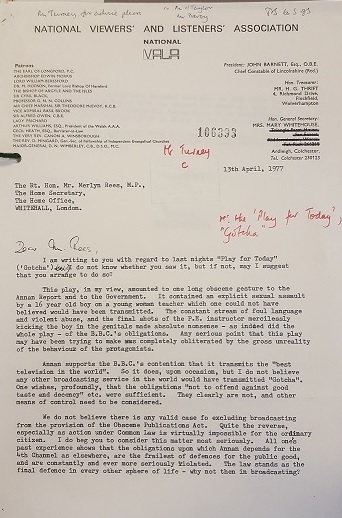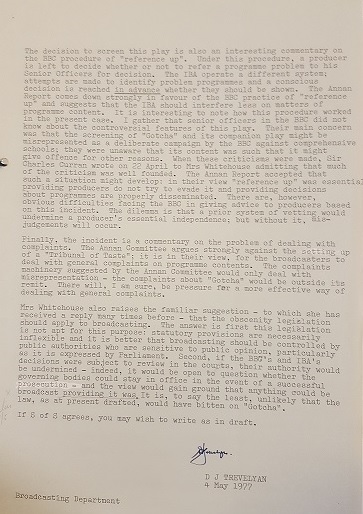In 1977 there was still a year to go until the full blown industrial strife of 1978/79, yet to many young people the blazing hot summer of 1976 was already a far-flung memory. Employment was getting ever harder to come by, and even then there were no guarantees of ongoing work. A promised golden future of high-rise housing had instead created an intimidating urban landscape.
As in previous decades, the youth of 1977 embraced anti-establishment heroes, but the well-tailored rebellion of the 1950s ‘Teddy Boys’ and the bohemian peace and love of the 1960s had given way to an unfulfilled nihilism, waving its abrasiveness proudly. To the concern of many parents, teenage bedroom walls were suddenly plastered with the less-than-friendly visages of John Lydon (best known as Johnny Rotten), Joe Strummer of The Clash and Star Wars’ Darth Vader (a villain more popular with youngsters than the heroes that he fought).
Punks and ‘drop outs’
The early followers of Lydon and his bandmates were far from the caricatured punk image we see on tourist postcards now; they appeared to terrify the bulk of the populace with both their appearance and antisocial actions. In Central London these youths were seen to give a negative representation to tourists.
The statue of Eros and the area around Piccadilly Circus Underground Station had long been an assembly point for young people (the file at The National Archives about vagrancy at Eros goes back to 1969 and is titled ‘Hippies and others’). But in the late seventies this location appeared to become a re-energised hive of activity. The file about the policing of the area around Eros can be found in MEPO 31/43.

The letter received by the Home Secretary from Mrs Bliss (catalogue reference: MEPO 31/43)
Members of the public were not happy about what they saw. In a letter received by the Home Secretary, Mrs Nora Bliss voiced her concern about the people she saw gathering around the Piccadilly Circus area.
Mrs Bliss began:
‘I am wondering if you can do anything to disperse the drop outs, drug addicts etc. who congregate down Piccadilly Underground Station.
Last evening at around 5.30 a couple were copulating outside the menswear shop in the arcade, a girl was lying unconscious on the steps to the entrance in Piccadilly and the usual gang of dirty, offensive people were hanging about outside the ladies lavatory.’
She noted the absence of police officers in the area, and wanted to know why these individuals were allowed to congregate at the station, stating:
‘The commuter pays enough for the doubtful privilege of travelling by tube without having to put up with the offensive language and behaviour of these drop-outs who block the entrances to the station.’
Mrs Bliss was worried that the behaviour of the crowd at Piccadilly was becoming a tourist attraction, causing further congestion at the station as tourists gathered around the area to view the antics of the ‘drop-outs’. However, she was able to offer a recommendation. ‘The only solution it seems to me,’ she wrote, ‘is for Boots (and probably other chemists in the area) to stop supplying the drugs that these people exist on.’
Policing Piccadilly
The authorities took the matter of policing this area around Piccadilly Circus tube station very seriously. While they had every intent of prosecuting those acting in an anti-social manner, they were hindered by the precedent set by an earlier court case, ‘Ellerby and Others’, heard on 16 December 1975. Two people changed with delinquency at Piccadilly under the Highways Act had been acquitted. The Bow Street Magistrates overseeing this case believed that the subway entrances at Piccadilly were not covered by the Highways Act of 1959.
In a Metropolitan Police memo dated 4 December 1979, Area Commander W C Matthews suggested that as most of the offences were taking place near the Underground station, action could be taken under the London Transport Executive Bye Laws of 1965. This line of approach appeared successful, as in a Police communication dated 4 July 1980, Acting Commander A Gibson writes about the area at Piccadilly:
‘Credit to the officers that the offensive behaviour described in Mrs Bliss’s letter is no longer prevalent.’
Mary Whitehouse and ‘Gotcha’
Perhaps the key public figure of an older generation who found themselves at odds with the new, more brazen youth culture was Mary Whitehouse. With her National Viewers and Listeners Association she had been on a long campaign to clean up the content shown by British broadcasters.

Letter sent by Mrs Whitehouse to the Home Secretary, complaining about the BBC’s transmission of the play ‘Gotcha’ (catalogue reference: HO 256/963).
On 13 April 1977 she wrote to Merlyn Rees, in his capacity as Home Secretary, to complain about the transmission of the play ‘Gotcha’ on BBC One on 12 April 1977 (HO 256/963).
The televised play was a one off in the series ‘Play for Today’. It starred Phil Davis as an unnamed teen who, on his last day at school, held two of his teachers and his headmaster as hostages. The bullying PE teacher who became his captive was portrayed by Gareth Thomas (perhaps better known as the intergalactic freedom fighter Roj Blake in the BBC’s ‘Blake’s Seven’). ‘Gotcha’ prompted many questions about the barren future that lay ahead for the youth of 1977.
‘This play in my view amounted to one long obscene gesture to the Annan report and to the Government,’ wrote Mrs Whitehouse about ‘Gotcha’. The Annan Report of 1977 recorded the findings of the Annan Committee which discussed the future of the British broadcasting industry, including its televised standards.
‘It contained an explicit sexual assault,’ declared Mrs Whitehouse of the play. ‘The constant stream of foul language and violent abuse and the final shots of the PE instructor mercilessly kicking the boy in the genitals made absolute nosence [sic] – as indeed did the whole play of the B.B.C.’s obligations.’
With her seeing a ‘gross unreality’ in the play’s depiction of a teenager of 1977, it appeared that Mrs Whitehouse was oblivious to the type of behaviour that had been reported at Piccadilly.
The Home Office response
Whitehouse suggested that the material should be dealt with under the Obscene Publications Act; neither the Home Secretary nor the BBC agreed.
Correspondence from D J Trevelyan of the Broadcasting department at the Home Office outlined some objections:
‘This legislation is not apt for this purpose… it is better that broadcasting should be controlled by public authorities who are sensitive to public opinion… if the BBC’s or IBA’s decisions were subject to review in the courts, their authority would be undermined – indeed, it would be open to question whether the governing bodies could stay in office in the event of a successful prosecution.’

The notes sent by D J Trevelyan of the Home Office about how to respond to Mrs Whitehouse’s letter of complaint (catalogue reference: HO 256/963)
The reply to Mrs Whitehouse sent on behalf of the Home Secretary noted that BBC programming was ‘entirely a matter for the broadcasting authorities to decide’.
Charles Curran, the BBC’s then Director General, also responded to Mrs Whitehouse, writing that while he did regret ‘the excesses of the language, and the implied violence’ he would not ‘go so far to describe the play as obscene’.
Despite the firm tone of Curran’s letter, Mrs Whitehouse appeared to take his regret as a victory, declaring her success at getting an apology from the BBC in several national newspapers (clippings from these can be found in HO 256/963).
A question of money
Perhaps the last word on ‘Gotcha’ should go to one of its stars. When interviewed by the Blake’s Seven fan magazine ‘Freedom City Gazette’, Gareth Thomas stated that Mrs Whitehouse had been successful in her demand for a repeat showing of ‘Gotcha’ to be cancelled, while recalling that there had been no copycat incidents of pupils kidnapping teachers (which he incorrectly appeared to assume was her main complaint). But his chief issue with Mary Whitehouse was a practical one:
‘I wrote to her, actually and I said, “Regardless of your moral attitude, I feel that if I had the money, which I don’t (aren’t you lucky!) I would sue you for loss of wages, because when it’s repeated I get more money, and who the hell are you to turn around and say I will stop that man from getting more money.’
‘I never got a reply,’ lamented Thomas.
I don’t disagree with what you say about Mrs Whitehouse perhaps not knowing about the events in the Piccadilly underground station area, if I recall correctly didn’t Mrs Whitehouse complain about the play “The Romans” (censorship was only lifted from plays in the mid-1960s when the Lord Chancellor I think could veto a play, just like in a Communist country) and it was then revealed she had never seen it!. She of course wanted to get rid of Dr Who, she was right on one occasion on a scene that was left from one week to the next, but I liked being scared watching it from behind the sofa and a lot of us grew up with the Daleks. Rather ironic that Gareth Thomas’ ship in ‘Blake’s 7″ was called the Liberator (of course created by Terry Nation, the man who created The Daleks). As far as unemployment went you can blame the Treasury was to blame for that, the swinging cuts of 17 December 1973 (not often mentioned) was so bad tat Treasury officials had little work to do with departments unable to spend money and which would last through 1976 and Denis Healey having to get money from the International Monetary Fund ‘with strings attached’ (?what has changed).